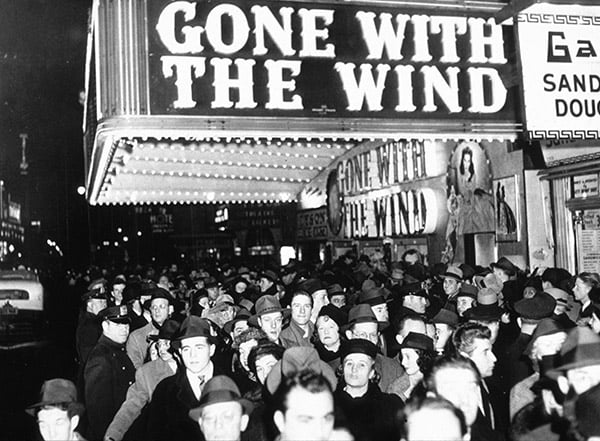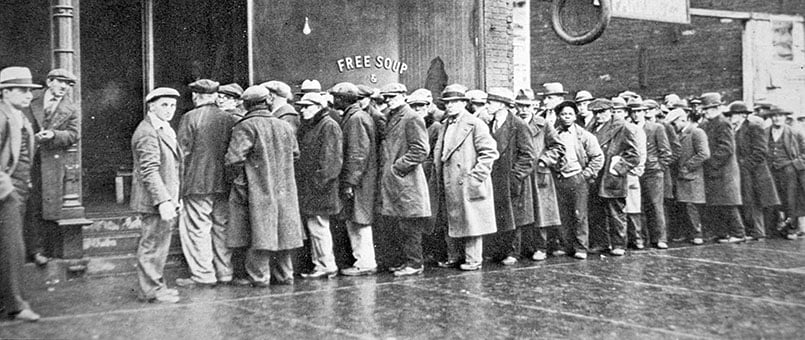
Unsure Futures: America in the 1930s
“So, first of all, let me assert my firm belief that the only thing we have to fear is…fear itself — nameless, unreasoning, unjustified terror which paralyzes needed efforts to convert retreat into advance.” – Franklin D. Roosevelt
On March 4, 1933, Franklin D. Roosevelt stood at the United States Capital in Washington D.C. and spoke frankly and honestly to the American people who had just elected him the 32nd President of their country. In the grips of an unsettling, bleak future brought on by the Great Depression, FDR assured his country that the “only thing we have to fear is fear itself.” As the Royal Academy prepares to welcome the Art Institute of Chicago’s exhibition America after the Fall: Paintings in the 1930’s, Bridgeman Images takes a look back at the art work and reality of a country in economic turmoil.
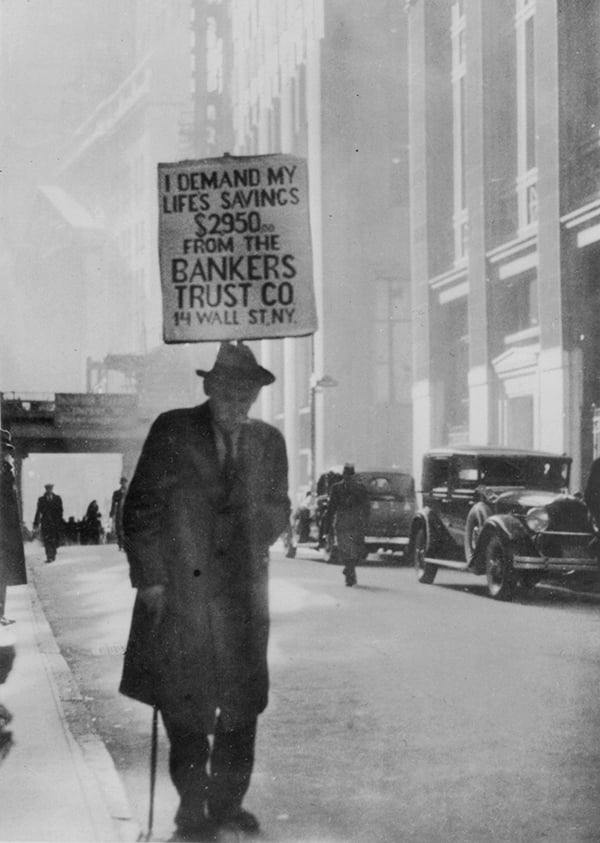
The Wall Street Crash, c.1929 (b/w photo), Zinnemann, Fred (1907-1997) / Private Collection / The Stapleton Collection
The Fall
When looking back to the decade of the 1920s, the United States seemed to be in the prime of its life: innovation, glamour, and jazz. The country had just survived its first world war and people were living rather lavishly in many parts of the country and investing in inventions such as the television and the electric toaster. Fortunately for these people, even though they did not have the funds to keep up with this lifestyle, the American banks were more than happy to provide credit and loans to citizens if they so desired.
Life seemed great in the high societies of America’s major cities. Moving away from these little pockets of civilization, however, the grizzly truth was beginning to encroach on these vulnerable cities. The ending of World War I left many men in rural communities without work and the unemployment rate skyrocketed. Farming communities began to fail due to the nation’s merchants and grocers seeking cheaper produce internationally. The middle of America was collapsing, and this dark cloud of reality quickly made its way to one of the most populous cities in America: New York City.
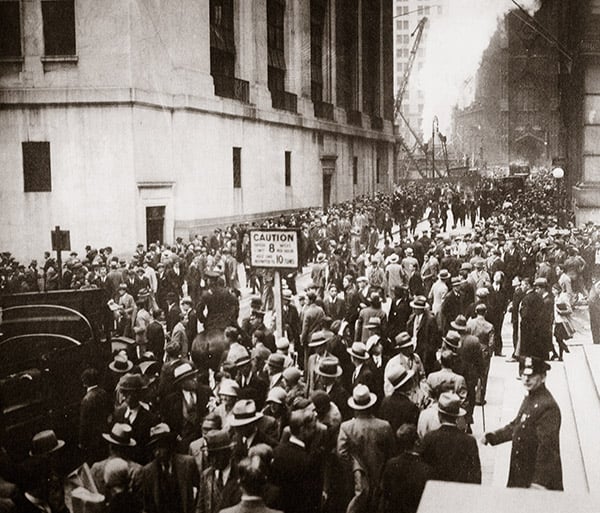
The Wall Street Crash: Thursday 24th October, 1929 (b/w photo), American Photographer, (20th century) / Private Collection / The Stapleton Collection / Bridgeman Images
October 29th, 1929, also referred to as Black Tuesday, is the day of the infamous Stock Market Crash. To this day, this event was the worst financial crisis the country, as well as many other Western civilizations, has ever experienced. Steel production (one of the US’s major commodities) and construction slowed, and in some cases even halted due to budget cuts, and many American citizens were racking up extremely high debt due to the easy nature of acquiring loans from the bank. Finally, everything came to a head, and the stock prices crashed, leading to a widespread panic. As people began withdrawing all their savings from banks they believed to be unsound, over 4,000 banks were forced to close their doors for they were unable to compensate the masses of withdrawals after authorizing so many loans. In short: the banks were out of money — the American people’s money.
People were forced to sell personal items, such as wedding rings and family heirlooms to pay for food for their families. Many were forced to sell their houses, and even default on their mortgages, forcing families into foreclosure. The financial crisis led to massive unemployment, with a majority of American families slipping into poverty.
The Great Depression
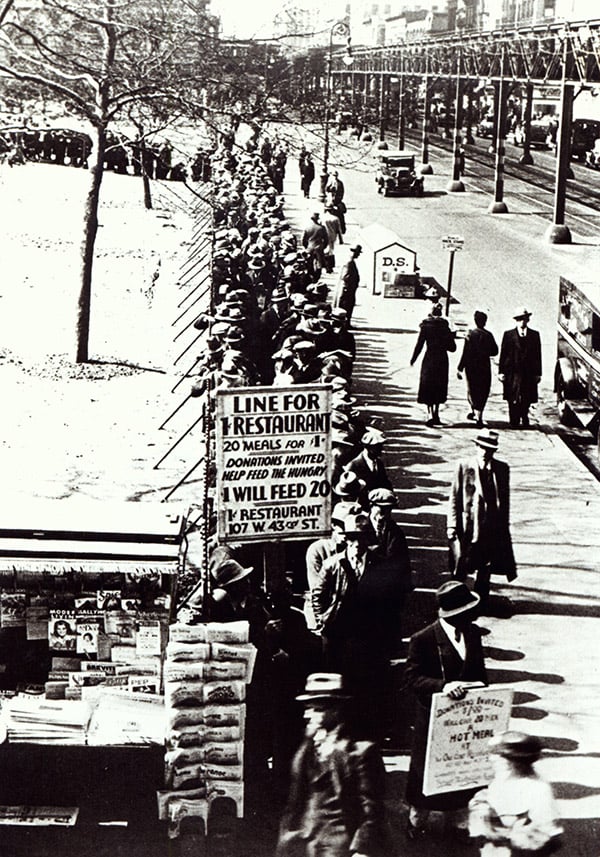
Cheap food line at Bryant Park, New York, during the Great Depression, 1931 (b/w photo), American Photographer, (20th century) / Private Collection / Peter Newark American Pictures
After the American financial crash, many families were homeless, starving, and desperate for work. There was no sense of a national government at this point in time. The government has little impact on ordinary citizens, and there was no social security funding or unemployment aid. There was no established safety net for the American people.
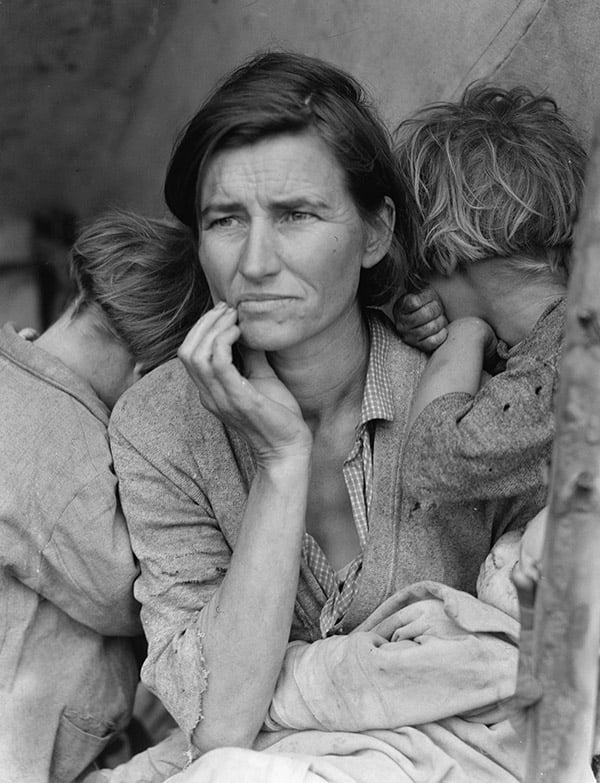
Destitute pea pickers in California. Mother of seven children. Age thirty-two. Nipoma, California, 1936 (b/w photo), Dorothea Lange (1895-1965) / Private Collection / Bridgeman Images
Major droughts surfaced across American farmland, resulting in miles of infertile lands, dangerous dust storms, and farmers abandoning their farms to travel to major cities in California in search of a new life, only to find the grass wasn’t any greener on the other side. Photographers such as Dorothea Lange rose to prominence during this time, working for the Farm Security Administration by documenting the life of farm families and communities effected by the economic downfall.
Art and Culture during the Depression
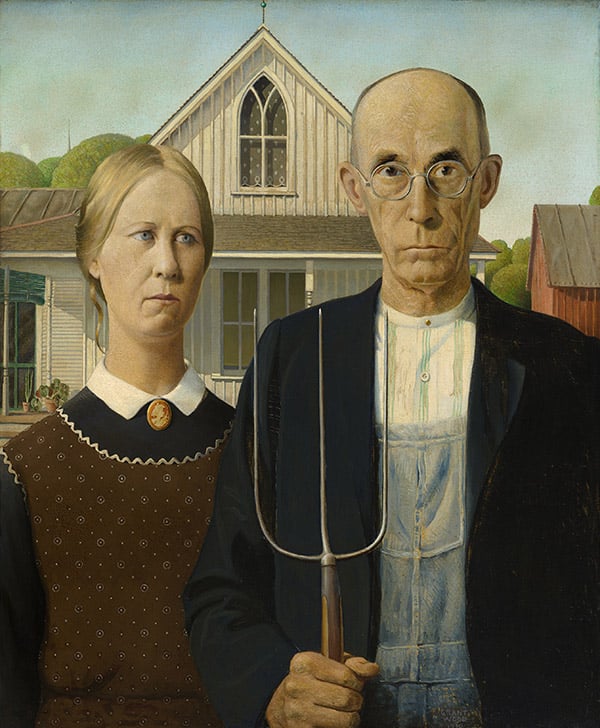
American Gothic, 1930 (oil on beaver board) , Grant Wood (1891-1942) / The Art Institute of Chicago, IL, USA / Friends of American Art Collection / All rights reserved Wood Graham Beneficiaries and Figge Art Museun / VAGA, New York
Despite the desolate times and unsure futures of the American people, there was an improvement in the creation of entertainment and art. People yearned for an escape from reality and were desperate for anything that would distract them from the state of their lives. Though many sold their furniture and personal effects to scrape some money together for living expenses, a lot of families refused to part with their radio. Radio dramas became an extremely popular form of entertainment, as well as movies. Families would spend what little money they had left over on a trip to the movies which, in the 1930s, would be an all day event. Some screenings would last up to 15 hours, and include multiple forms of entertainment: a news report, a cartoon, and a motion picture.
While looking back at film and radio drama during the time, one may not get the proper idea of what life was like during this dark time in America’s past. These forms of entertainment were focused on engaging people in a happy, almost dreamlike way. It gave people a chance to disappear from reality for a few hours. To get a true sense of what was reality, one must turn to the artwork created during this time. The 1930s became a renaissance of sorts for American painters.
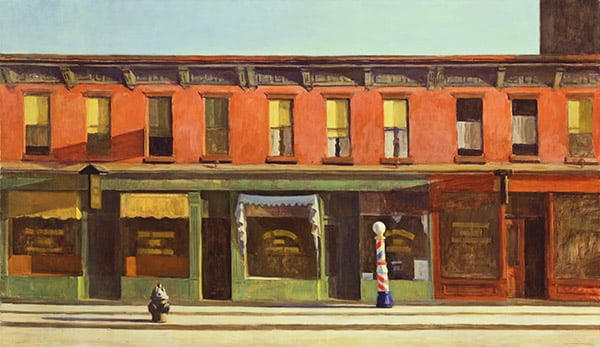
Early Sunday Morning, 1930 (oil on canvas), Edward Hopper (1882-1967) / Whitney Museum of American Art, New York, USA
The politically varied works produced in the 1930’s create an interesting juxtaposition to the nation‘s changing states of mind. Edward Hopper‘s work focused on a melancholy reality of small town America whilst artists like Thomas Hart Benton wanted to create a sense of bold romanticism that tried to create a national art that honored America. There were also painters such as Philip Evergood and Joe Jones who opted to create work that acted as a protest against political attitudes of the time, highlighting the troubles of farmers, Jewish people, and other minority groups.
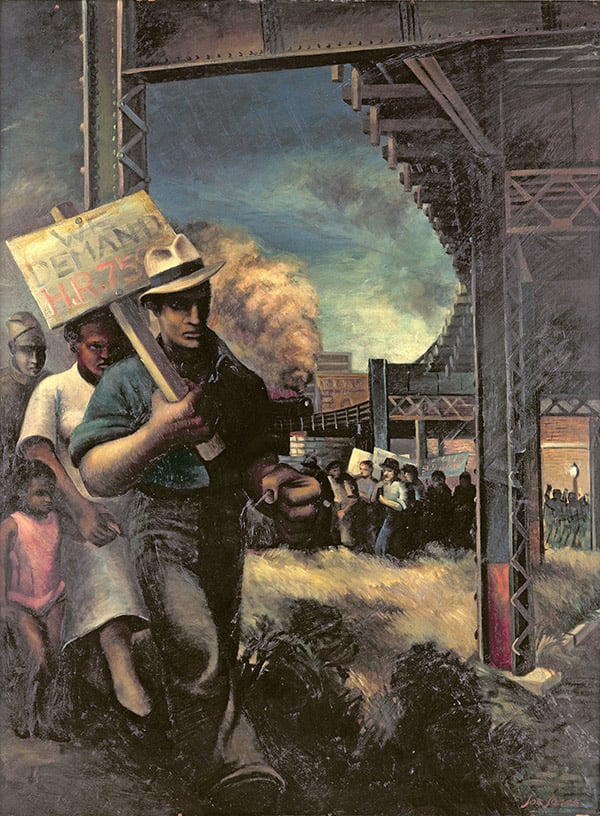
We Demand, 1934 (oil on canvas), Joe Jones (1909-63) / Butler Institute of American Art, Youngstown, OH, USA / Gift of Sidney Freedman 1948 / Bridgeman Images
FDR and the Beginnings of a New America
President Hoover’s attempt at reelection was almost a guaranteed loss. The American people associated him with the complete failure of America, nicknaming shanty towns “Hoover-villes” and referring to newspapers as “Hoover blankets.” When Franklin D. Roosevelt (FDR) ran as his Democratic counterpart, people were drawn to him. His speeches were optimistic, his demeanor was confident, and, most importantly, he was not Herbert Hoover. In a landslide victory, FDR was elected the 32nd President of the United States, and one of his first orders of business was to close every bank in order to rebuild the system. Once reopened, deposits into the bank surpassed withdrawals, a small glimmer of hope.
FDR proceeded to employ as many people as he could by putting them on the government payroll. Instead of relying on the hiring of private enterprises, FDR hired men and women to work in various areas of lower-level government. By basically redesigning the role of the government, FDR was able to create a government that was designed for the people. He introduced welfare, government issued pensions, and a more centralized bank system. The United States began to experience recovery after years of hopelessness.
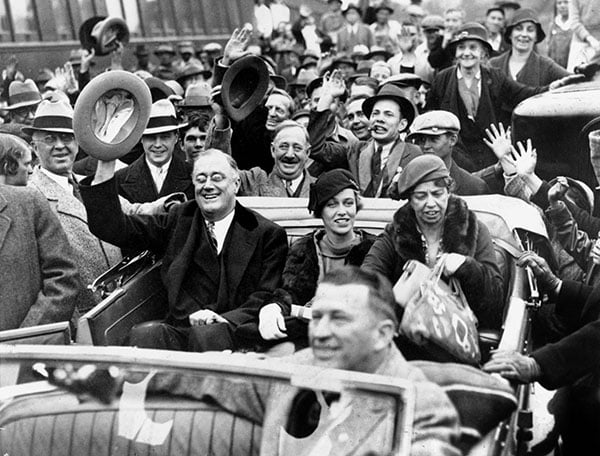
Franklin Delano Roosevelt (1882-1945) in convertible car during electoral campaign for Presidential elections in 1932 / Bridgeman Images
Read more
Take a closer look at the Great Depression and American art from the 1930s.

